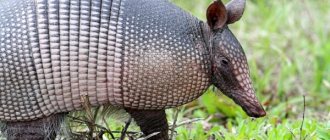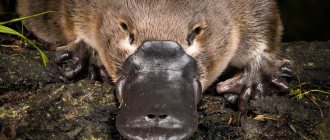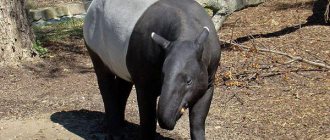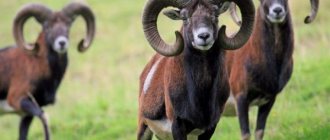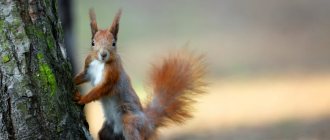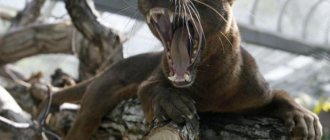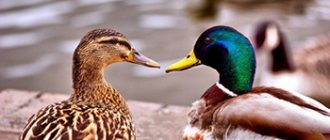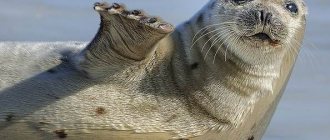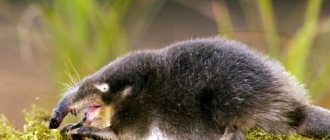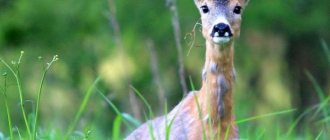The gazelle, or as it is often called, the goat antelope, is one of the animals that are included in the Red Book under the status of a type that has almost completely disappeared from the territory of Russia. Unfortunately, industrial interest in this species of animal at one time led to the fact that the type almost completely disappeared from this territory.
The gazelle is a small, slender and even light antelope. Light because its weight does not exceed 30 kilograms and its length is about half a meter. They also have a tail - only 10 centimeters, but very mobile. The legs of antelopes are quite strong, but at the same time thin. This body design allows them to easily and quickly cover long distances and run away from danger.
Males are slightly different from females - they have a small protrusion in the area in the throat called a crop, and horns. Females do not have horns. Both the former and the latter have a sandy-yellow color, and closer to the belly it becomes lighter, almost white.
The horns of gazelles are relatively small - only 30 centimeters in height. At the base they are almost black, and closer to the top they become lighter. They are slightly twisted in shape. The height at the withers does not exceed half a meter.
Origin of the species and description
Photo: Dzeren
There are three species of these mammals from the bovid family, gazelles:
- Przhevalsky;
- Tibetan;
- Mongolian.
They differ little in appearance and lifestyle. In Central Asia, species of gazelles that have similar features to these animals still live. In the layers of the Upper Pliocene in China, remains of artiodactyl transitional species were found.
The gazelles split from the general antelope lineage around the Upper Pleistocene, before the genus Gazella appeared, which means they have an earlier origin. Some molecular genetic features suggest that the genus Procapra is close to the genus of dwarf antelopes Madoqua.
These artiodactyls were widespread back in the days of mammoths, about ten thousand years ago. They inhabited the tundra-steppes of North America, Europe and Asia, and with climate warming they gradually moved to the Asian steppe regions. Dzerens are extremely hardy. They can travel large spaces in search of food or water.
The habitat of this species is dry steppes with low turf. In the summer, they move easily, migrating within their usual range. In winter, animals can enter forest-steppe and semi-desert areas. They penetrate into forest areas during snowy winters, when it is difficult to obtain food in the steppe.
Video: Dzeren
These agile animals rarely stay in one place for more than two days, and when moving they can reach speeds of up to 80 km per hour. They freely cover ten kilometers at a speed of 60 km per hour, surpassing many ungulates in running endurance, and not a single predator can compare with them in this. During the migration period, gazelles cover up to 200 km per day.
The lifespan of females is 10 years, and that of males is four years shorter. Males spend a lot of energy during the rutting season, which takes place in December, the coldest time of the year. After this, it is difficult for them to survive the harsh winter; by spring, weakened males die more often than females. Sexual maturity of males occurs at 2-3 years, after which they go through the mating period about three times and die in the teeth of predators or in extreme conditions of snowy winters.
[edit] Systematics
Previously, the order of armadillos was included in the order of incomplete teeth (lat. Pilosa) as one of the families, now they are separated into a separate order.
Squad Armadillos (Cingulata)
- Family Armadillos (Dasypodidae) Genus Bare-tailed armadillos (Cabassous)
Species Central American armadillo (Cabassous centralis) (Miller, 1899) - Species Chaco armadillo (Cabassous chacoensis) Wetzel, 1980
- Species of Armadillo tattoo (Cabassous tatouay) (Desmarest, 1804)
- Species Great armadillo Cabassous unicinctus (Linnaeus, 1758) Subspecies Cabassous unicinctus squamicaudis (Lund, 1845)
- Subspecies Cabassous unicinctus unicinctus (Linnaeus, 1758)
Genus Shield-bearing armadillos (Calyptophractus)
- Species Shield armadillo (Calyptophractus retusus Burmeister, 1863)
Genus Chaetophractus (Chaetophractus)
- Species Chilean armadillo Chaetophractus nationi (Thomas, 1894)
Species Long-haired armadillo (Chaetophractus vellerosus) (Gray, 1865) Subspecies Chaetophractus vellerosus pannosus (Thomas, 1902)
Subspecies Chaetophractus vellerosus vellerosus (Gray, 1865)
Species Bristleback armadillo (Chaetophractus villosus) (Desmarest, 1804)
Genus Frilled armadillos (Chlamyphorus)
- Species Frilled armadillo (Chlamyphorus truncatus)
Species Mole armadillo Chlamyphorus retusus (Burmeister, 1863)
Genus Nine-banded armadillos (Dasypus)
- Species Short-tailed armadillo (Dasypus hybridus)
Species Kappler's armadillo (Dasypus kappleri) Species Nine-banded armadillo (Dasypus novemcinctus) Species Hairy armadillo (Dasypus pilosus) Species Northern armadillo (Dasypus sabanicola) Species Seven-banded armadillo (Dasypus septemcinctus) Species Argentine armadillo (Dasypus yepesi)
Genus Six-banded armadillos (Euphractus)
- Species Six-banded armadillo (Euphractus sexcinctus)
Genus Giant armadillos (Priodontes)
- Species Giant armadillo (Priodontes maximus)
Genus Three-banded armadillos (Tolypeutes)
- Species Ball-shaped armadillo (Tolypeutes matacus)
Species Three-banded armadillo (Tolypeutes tricinctus)
Genus Dwarf armadillos (Zaedyus)
- Species Pygmy armadillo (Zaedyus pichiy)
Appearance and features
Photo: Animal gazelle
In size, the gazelle is similar to the Siberian roe deer, but with a more massive body, short legs and lowered hindquarters. The animal has thin legs with narrow hooves and a rather large head. The muzzle is high and blunt with small ears - 8-13 cm. Tail length is 10-15 cm. These artiodactyls have excellent vision and see danger from afar, and they also have a well-developed sense of smell. Hearing in the steppes, where windy weather often occurs, is not so important.
Main Dimensions
The male reaches 80 cm at the withers, and up to 83 cm at the rump. Females are smaller, their figures are 3-4 cm less. The body length of males from the muzzle to the tip of the tail is 105-150 cm, in females - 100-120 cm. Males weigh about 30-35 kg, reaching 47 kg by autumn. In females, the weight ranges from 23 to 27 kg, reaching 35 kg in the autumn.
Horns
At the age of five months, males have bumps on their foreheads, and in January their heads are already decorated with horns up to 7 cm long, which grow throughout their lives, reaching 20-30 cm. Their appearance resembles a lyre, in the middle with a bend back, and to the top - inward. The horns are smooth on top, light gray with a yellow tint. Closer to the base they become darker and have thickenings in the form of ridges from 20 to 25 pieces. Females are hornless.
Goiter
Male Mongolian gazelle have another characteristic difference - a thick neck with a large larynx. Due to its protrusion forward in the form of a hump, the antelope received its second name - googly. During the rut, this place in males becomes dark gray with a bluish tint.
Wool
In summer, the artiodactyl has a light brown, sandy color on its back and sides. The lower part of the neck, belly, croup, and part of the legs are white. This color extends above the tail onto the back. In winter, the coat becomes lighter, without losing its sandy shade, and with cold weather it becomes longer and fluffier, which is why the appearance of the Mongolian antelope changes. The animal becomes visually larger and thicker. Longer hair appears on the forehead, crown and cheeks. Above the upper lip and on the sides, the hairs bend inward with their ends, creating the impression of a mustache and swelling.
The wool is soft to the touch, there is no clear separation of the guard and the undercoat. The ends of the hair are brittle. Animals shed twice a year – in spring and autumn. In May-June, the winter long (up to 5 cm) and coarse wool falls off in clumps, and a new summer coat (1.5-2.5 cm) appears under it. In September, the ungulate again begins to grow thicker and warmer cover.
Behavior
Bristle-clad armadillos live in pairs or are solitary. In summer, they go out in search of food at dusk and remain active until dawn. In winter, they feed more often during daylight hours.
The animals independently build two types of underground shelters. In soft soil they dig small and shallow burrows, and in hard soil they dig large and long ones, with numerous passages and branches. The first type is used as temporary shelters, while the second serves as a permanent home.
This approach better helps adaptation in hot desert areas. The shelters are located at a depth of 50 to 100 cm. You can get into them through an entrance hole with a diameter of about 20 cm.
Inside the burrow there is a brood chamber about 50 cm long and 20 cm wide. Its height reaches 30 cm. Abandoned burrows are often occupied by rabbit owls (Athene cunicularia) and lowland viscachas (Lagostomus maximus).
Where does the gazelle live?
Photo: Gazelle antelope
Mongolian antelopes live in the steppes of China and Mongolia. During migrations, they enter the Altai steppes - the Chuya Valley, the territory of Tyva and the southern part of Eastern Transbaikalia. In Russia, there is currently only one permanent habitat for these artiodactyls - the territory of the Daursky Nature Reserve. The Tibetan gazelle is slightly smaller than its Mongolian relative, but with longer and thinner horns. Habitat in China - Qinghai and Tibet provinces, in India - Jamma and Kashmir. This species does not gather in herds, choosing mountain plains and rocky plateaus for living.
The Przewalski's gazelle lives naturally in the eastern Chinese Ordos Desert, but most of the population is located in a reserve on the shores of the Kukunoor salt lake in China. In the 18th century The Mongolian antelope lived in Transbaikalia throughout the steppe zone. In winter, the animals migrated north as far as Nerchinsk, entering the taiga during heavy snowfalls and crossing forested mountain ranges. Their regular wintering in these areas can be judged by the preserved names with the name of the animals (Zeren, Zerentui, in Buryat dzeren - zeeren).
In the 19th century The habitats and numbers of antelopes in Transbaikalia have decreased significantly. This was facilitated by mass extermination during hunting and their death in snowy winters. Migration from China and Mongolia continued until the mid-20th century. During wartime, in the forties, the meat of these mammals was prepared for the needs of the army. Over the next two decades, the free sale of hunting weapons and poaching completely exterminated the livestock in Transbaikalia, Altai and Tyva.
What does a mongoose look like?
There are 35 species in the mongoose family in two subfamilies and 17 genera. The subfamily Galidiinae (4 genera and 5 species) is endemic to Madagascar. The most famous representative is the ring-tailed mungo; it and two other species of the subfamily of Madagascar mongooses have striped coloring.
Species of the subfamily Herpestinae live in Africa and Asia. This includes 13 genera and 30 species, including the meerkat, common, dwarf and yellow mongoose. All species of the family, as a rule, have a uniform body color.
In terms of external structure, the animals are similar to mustelids and viverrids. They are small: body length from 17 cm (dwarf) to 60 cm (white-tailed mongoose), tail length - from 19 to 45 cm. Their weight varies from 320 g to 5 kg. The body is elongated, the legs are relatively short. The limbs are five-fingered, with non-retractable claws. The head is small, with an elongated, pointed muzzle and small ears. The tail is long and bushy, usually thick at the base and tapering towards the end.
The fur of the animals is long, rough, often with graying or speckles. Its color varies from dark gray to brown, yellow or reddish. The color of the limbs, tail or its tip often differs from the color of the body. The banded mongoose and meerkat have dark brown stripes on their backs.
Many species have a large anal sac with at least 2 openings. Scent marks from the anal and buccal glands inform relatives of belonging to a certain sex and readiness for reproduction.
Photos of some members of the family are presented below.
The white-tailed mongoose is the largest representative; inhabits sub-Saharan Africa. Active only at night, it is very difficult to see even in places where it is common.
White-tailed mongoose (Ichneumia albicauda)
The dwarf mongoose is the smallest species. Found from Ethiopia to South Africa, west to Namibia, Angola and Cameroon.
Dwarf mongoose (Helogale parvula)
Ring-tailed mungos live in the tropical forests of Madagascar; live in pairs or small family groups; spend a lot of time in trees.
Ring-tailed mungo (Galidia elegans)
The water mongoose is found in Gambia. As the name suggests, this species is closely associated with water and is often found near ponds and swamps.
Water mongoose (Atilax paludosus)
The meerkat inhabits South Africa, Botswana, Angola and Namibia. The animals live in colonies like gophers, which is quite unusual for predators. You can learn more about meerkats from this article.
Meerkats (Suricata suricatta)
The common mongoose is distributed from the Arabian Peninsula to Nepal, India and Sri Lanka. Inhabits semi-aquatic forest biotypes. Leads a solitary lifestyle.
Common mongoose (Herpestes edwardsii)
Indian are found throughout India, in Sri Lanka. Poisonous snakes often become prey for this species. It was probably he who became the hero of Kipling's famous story.
The photo shows a fight between a fearless mongoose and a cobra.
Indian mongoose (Herpestes smithii)
What's for lunch?
Among mongooses there are both polyphagous predators and exclusively insectivorous species. Their diet includes insects and other terrestrial invertebrates, small vertebrates, crabs, fish, bird eggs, and sometimes fruits and plant bulbs. Leading a semi-aquatic lifestyle, the water mongoose feeds mainly on small aquatic vertebrates. The structure of the limbs of these animals reflects their feeding habits. Long, non-retractable claws are well suited for digging. Moving slowly, the animal sniffs the ground, and as soon as it finds an insect, it either grabs it from the surface or quickly digs it out of the ground.
What does gazelle eat?
Photo: Dzeren in Transbaikalia
The main food of the goiter antelope is grasses of the steppes, in their usual habitats. Their diet differs little in composition from the changing seasons of the year.
In summer these are cereal plants:
- thin-legged;
- chamomile;
- feather grass;
- feather grass;
- snake
Forbs, cinquefoil, many-rooted onions, tansy, solyanka, wormwood, and various legumes are readily eaten by them. Part of the diet consists of shoots of caragana and prutnyak shrubs. In winter, depending on the habitat, the main share in the menu of the Mongolian antelope falls on forbs, feather grass or wormwood. Wormwood is preferred; by winter it remains more nutritious than other available plants and contains more protein.
Despite the large crowding of animals, there is no disturbance of the grass in the steppe, since the herd does not stay long in one place. In summer it can return to its original site after 2-3 weeks, and in cold periods - after several months or even years. During this time, the grass cover has time to recover. Antelopes bite only the tops of the grass, causing its tillering and secondary vegetation.
These mammals drink little, being content with the moisture supplied by the grass. Even females do not go to water for one to two weeks during the calving period. These artiodactyls need daily water consumption in the spring and autumn, when there is no snow and the steppe plants are still dry. In winter, the source of moisture is ice or snow, in the warm season it is streams, rivers and even salt lakes.
How do armadillos reproduce?
Most armadillos are loners. Only occasionally can you see a couple or a small group of animals.
Female armadillos give birth to several babies, which develop from one egg, so the babies have the same sex. Strange as it may sound, the offspring are in the armadillo litter, and you can count from a few to more than a dozen babies. Small newborn animals are born sighted, covered with soft skin. Within a few hours they begin to walk, but remain close to their mother for several more months. Armadillos reach sexual maturity around 2 years of age.
Features of character and lifestyle
Photo: Siberian gazelle antelope
The highest activity of these animals during the day occurs in the evening, early morning and first half of the day. They sleep in the afternoon and also in the second half of the night. It is difficult for antelopes to overcome snow-covered spaces and walk on crust. On the ice, their legs spread apart, there they move in dense clusters, supporting each other. Dzeren do not obtain food from under the snow; if the thickness of the cover is more than 10 cm, they move to other territories.
At the end of June - beginning of July, babies weighing 3.5 - 4 kg appear in the herd. They rise to their feet an hour after birth, but for the first three days they lie more in the shade of tall grasses. At this time, females graze at a distance so as not to attract the attention of predators, but are always ready to repel the attack of a fox or eagle. Babies get up only during feeding. If an attack occurs at such a moment, the cubs first flee from the pursuer along with their mother, and then fall and are buried in the grass.
Although calves receive mother's milk until they are 3 to 5 months old, they try grass after the first week. After 10 - 12 days, the animals leave the calving grounds along with the newborns. In summer, huge herds with growing offspring move across a small area. Such movements prevent pastures from becoming depleted. By the winter rutting period, some of the juveniles have already separated from their mothers, but some continue to stay with them until the next calving. And only for a while, adult males do not allow them to approach their harem.
By autumn, migration picks up pace, some animals remain in the summer grazing areas, while the rest move further and further, capturing a larger area. The March migration is slower, with herds gathering at the same calving grounds each year.
Links
- [www.povodok.ru/encyclopedia/brem/art3165.html Frilled armadillo (Chlamyphorus truncatus) - Brem Encyclopedia.]
- [www.sidlab.ru/b49.php Frilled armadillo.]
- [ecos.fws.gov/speciesProfile/profile/speciesProfile.action?spcode=A00L Characteristics of the frilled armadillo on the US Fish and Wildlife Service website] (English)
- [www.msu.edu/~nixonjos/armadillo/chlamyphorus.html Characteristics of the genus “Chlamyphorus” on the “Armadillo Online” website] (English)
- [www.cricyt.edu.ar/institutos/iadiza/ojeda/Edentados/Chlamyphoros%20truncatus.htm Page about this species on the website of the Argentine Institute for Arid Zone Research] (Spanish)
Social structure and reproduction
Photo: Mongolian gazelle
Dzeren live in large herds of up to three thousand individuals, and this number lasts for several weeks. Before the calving period and during migrations, several herds are grouped into large aggregations of up to forty thousand units. From time to time they break up into small groups. For example, in winter, during the rut, and in spring, during the calving period, but the herd itself gathers after wintering near such a place.
The herds are mixed in gender and age composition, but during the autumn migrations, groups consisting only of males appear. During calving, small herds of females with babies and herds of males also appear. During the rutting season, the community is divided into harems, headed by a male; there are single applicants and a separate herd that does not take part in mating games.
Herding in large open spaces has positive aspects:
- in the use of pastures;
- during migrations;
- when fleeing from enemies;
- for safety of feeding and rest;
- when walking through deep snow and ice.
The leaders of gazelles are adult females; there may be several of them. In case of danger, the herd is divided, and each leader takes part of his relatives with him. Females begin to mate for the first time at one and a half years, and males mature at two and a half years. Older males do not always allow young people to participate in mating games. Sexual activity of males begins to appear in the second half of December and continues until the beginning of January.
Dzeren are polygamous, males mate with several individuals. The strongest representatives can hold up to 20-30 females on their territory. Over the course of a day, their number may change; some are repulsed, others leave or come of their own free will.
It is common for zoan antelopes to return to the same place for calving. The first time females give birth to offspring is two years old. Pregnancy lasts about 190 days. The calving period in the herd lasts less than a month; its peak, when up to 80% of females bear offspring, lasts about a week.
Southern elephant seal
The southern elephant seal is the largest representative of the pinnipeds. Lives in Antarctic and subantarctic waters. The length of the southern elephant seal reaches six meters, and its weight can reach four tons.
Most of the population lives in the Subantarctic. Previously, colonies of this species were in Tasmania, on King Island, Juan Fernandez Island and St. Helena Island. But massive fishing led to the complete destruction of these colonies.
The number of southern elephant seal species currently reaches 670–800 thousand individuals.
Class: Mammals
Order: Pinnipeds
Family: True seals
Genus: Elephant seals
Species: Southern elephant seal
The southern elephant seal (Mirounga leonina) is an animal of the seal family (Phocidae).
The southern elephant seal is the largest carnivore on our planet. Male southern elephant seals weigh an average of 2.2 tons. up to 4t. and can reach up to 5.8 meters in length. The largest specimen among the southern elephant seals, it reached a length of 6.85 meters and weighed about 5 tons.
Interesting Facts:
Southern elephant seals can remain underwater for more than twenty minutes. The documented record for staying under water was approximately two hours. The maximum depth to which southern elephant seals can dive is more than 1,400 meters. Elephant seals have a long, pendulous nose that resembles a trunk, which is why they are named that way. The elephant spends most of its life, more than 80 percent, in the ocean
Http://malpme.ru/samye-krupnye-zhivotnye-na-zemle/
The southern elephant seal lives along the coast of Antarctica and subarctic islands. Before man landed on Antarctica, elephant seals lived further north than they do now. The largest population lives on the island of South Georgia in the South Atlantic Ocean. The southern elephant seal is also found on the Kerguelen, Heard, Macquarie Islands and the Valdez Peninsula in Argentina.
When the southern elephant seal is on land, it is found along the coast on smooth sandy beaches or small rocks. They are on land only during the breeding season and molting season, which lasts 3–5 weeks in the spring. The rest of the year is spent only at sea.
Dimorphism is observed not only in size. Males have a large trunk that increases vocalizations, used to challenge other males. The southern elephant seal's trunk is slightly smaller than those of their northern relatives, overhanging the mouth by only 10 cm, compared to 30 cm for the northern elephant seal.
Male southern elephant seals reach rookeries several weeks before females and, through vocalizations, body postures, and fighting, occupy a defined territory. The best and largest territories go to the largest and strongest males. These alpha males become the head of the harem, and with the arrival of women, it can include about 60 females. If there are more women in the harem, then the females go to the beta males. A man must remain on his territory, protecting it, and therefore must go without food for a long time. Lack of food and aggressive clashes with males, energy consumption in the process of mating with a large number of women lead to physical exhaustion of the male body. Only males in ideal physical condition are able to defend their territory for this long time.
If this does not deter the challenger, then fights take place.
The winner takes the territory as a prize.
The shedding process involves the loss of all fur, which grows over the next 3 to 5 weeks. Apart from spending time on land to breed and molt, the southern elephant seal lives a solitary life in the waters of the southern oceans. While in the water, elephant seals rarely encounter each other and thus have no need to communicate.
While at sea, the southern elephant seal can stay underwater for two hours, but most dives last no more than 30 minutes. Surprisingly, they spend 2–3 minutes between dives on the surface of the water. They dive to depths of 300 – 800 m.
Southern elephant seal and man
In the past, southern elephant seals were hunted for food, skin, and oil. This activity has been stopped and the animal is now protected and is harvested in limited quantities.
Natural enemies of gazelles
Photo: Dzeren Red Book
For small calves, danger comes from manulas, ferrets, foxes, and eagles. In winter, golden eagles can hunt adults, but their main enemy is the wolf. In summer, wolves rarely attack big-toothed antelope, since these animals can develop speeds that are beyond the strength of gray predators. In the warm season, a huge herd of gazelle lazily splits in two, allowing the predator to pass. In summer, a sick or wounded specimen can become prey for a wolf.
During calving, wolves also take care of their offspring and do not move far from the den, which is close to a water source, while antelopes do not go to water for several days. Newborns can become easy prey for wolves if their den is located near the area where the herd is calving. In this case, one family can eat up to five calves per day.
In autumn and spring, gray predators set up ambushes at watering places, which are very few in the snowless steppes. Males can be caught in the teeth of a wolf during the rut, in December, and weakened individuals - in early spring, in March. Predators also use the round-up method of hunting, when a couple of animals drive a herd into an ambush, where the entire wolf pack awaits the antelopes.
An interesting feature of this species of artiodactyls: when they see danger, they make characteristic sounds with their nose, strongly blowing air through it. Also, gazelles jump high to scare the enemy and stomp their feet, and take flight only when there is a real threat to life.
Armadillo diet
The standard diet of armadillos in natural conditions includes both animal and plant foods, but the main delicacy for such mammals is termites and ants. The insectivorous animal eats invertebrates and some insects, eating their larval stage, adults, as well as lizards, spiders, worms and scorpions. Armadillos are able to feed on carrion and food waste, as well as bird eggs and fruits.
Many species belong to the category of practically omnivorous animals. Representatives of the Armadillo order and the Armadillo family actively use their well-developed and incredibly sensitive nose, which allows them to sniff out food even underground. With the help of long and fairly strong claws, the prey is dug out, after which it is collected with a long, very sticky tongue and eaten.
Population and species status
Photo: Transbaikal gazelle
The population of the Tibetan species of these antelopes is about ten thousand. Przewalski's gazelle is rare - about a thousand individuals. Mongolian gazelles number more than 500 thousand individuals, according to some sources - up to a million. In Transbaikalia, after the complete disappearance of this species of artiodactyls in the 70s of the last century, the population began to recover.
Breeding of these mammals began in the Daursky Nature Reserve in 1992. In 1994, the Dauria protected zone was created, covering an area of over 1.7 million hectares. In the mid-nineties, in Central and Western Mongolia there was a surge in the growth of the goat antelope population. They began to return to their old territories and expanded their migration area to Transbaikalia. An analysis of data obtained from observations of these mammals in Eastern Mongolia showed that the population there has declined significantly over the past 25 years.
The reasons for this phenomenon were:
- active extraction of underground resources;
- construction of roads in areas of artiodactyl migration;
- human agricultural activities;
- periodic outbreaks of diseases due to a decrease in the number of natural enemies.
Difficult weather conditions at the beginning of the 2000s led to a massive migration of Mongolian antelopes to Russia. Some of them remained to live in the Transbaikal steppes, in the area of the Torey Lakes. Now the habitat of sedentary groups in these places is more than 5.5 thousand m2. Their number is about 8 thousand, and during migrations from Mongolia it reaches 70 thousand.
Sea Otter in the Red Book
In the 18th and 19th centuries, there was a massive hunt for sea otters.
The species is at a critical stage of extinction. In 1911, an international agreement was issued, according to which the hunting of sea otters was prohibited. At the same time, the animal was listed in the Red Book of the Soviet Union. The animal is protected all over the world. It is also included in the Red List of the International Union for Conservation of Nature and is protected by the CITES convention.
Main causes of extinction
Sea otters have very valuable fur. Therefore, mammals were actively exterminated for a long time. Experts estimate that mass hunting of sea otters has led to the death of one million individuals.
Other factors also cause great damage to individuals:
- economic activity;
- shipping;
- coastal pollution with waste from fishing enterprises.
For Alaskan natives, the predator is of food and cultural value, so they continue to exterminate this species.
Current population situation
Today, the number of sea otters has increased markedly compared to the beginning of the 20th century. The habitat remains intermittent. In 2006, there were about 12.5-15 thousand sea otters in our country.
In 2014, in America this figure was 55 thousand individuals, off the Californian coast - about 3 thousand individuals. In total, about 80 thousand sea otters live in the world. This is approximately 30% of the total number in the 18th century.
Currently, sea otters are kept in captivity for the purpose of study and exhibition. You can see the animal in zoos in Japan, Europe, and North America. The predator is found in aquariums in Chicago, Osaka, Lisbon, and Seattle.
What measures are taken to protect
In 1913, a reserve was opened in the Aleutian Islands to protect the habitats of sea otters. Hunting was banned in Russia in 1926. Japan stopped killing animals in 1946.
The Marine Mammal Conservation Act, passed in 1972, strengthened people's rights. Thus, the killing of sea otters is prohibited in most regions of the planet.
However, from 1990 to 2007, no visible population growth was observed. The reason lies in the mass of environmental problems. The human population in areas where sea otters gather is growing, and man-made risks are increasing.
Tanker accidents cause irreparable harm to the population. An oil spill leads to predators dying from hypothermia and lack of normal food.
